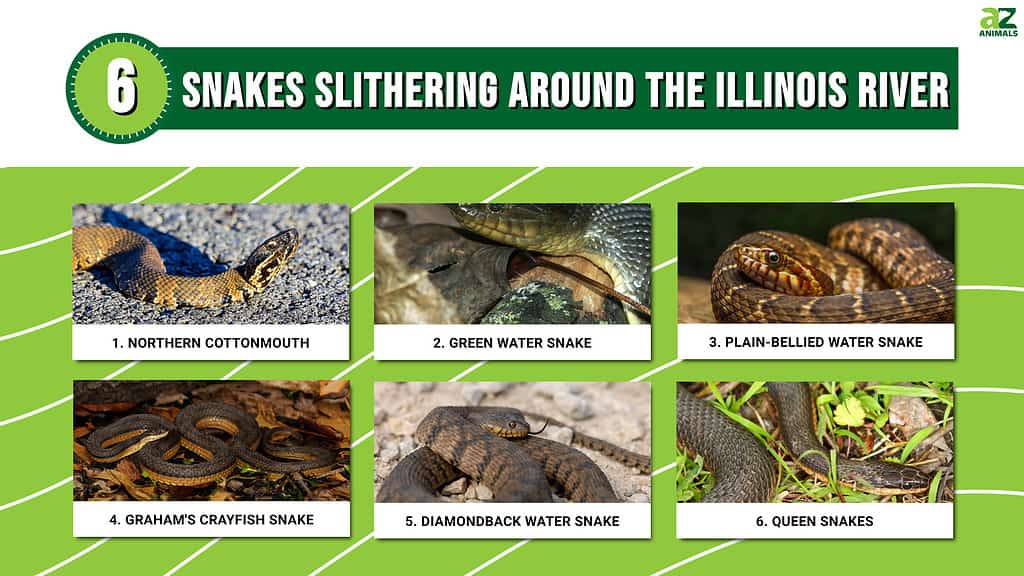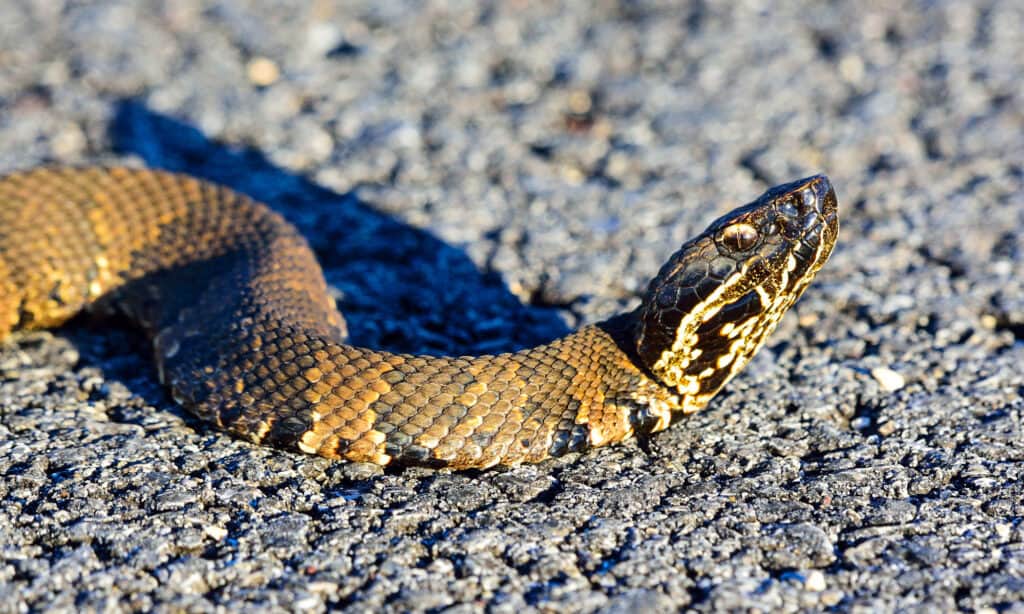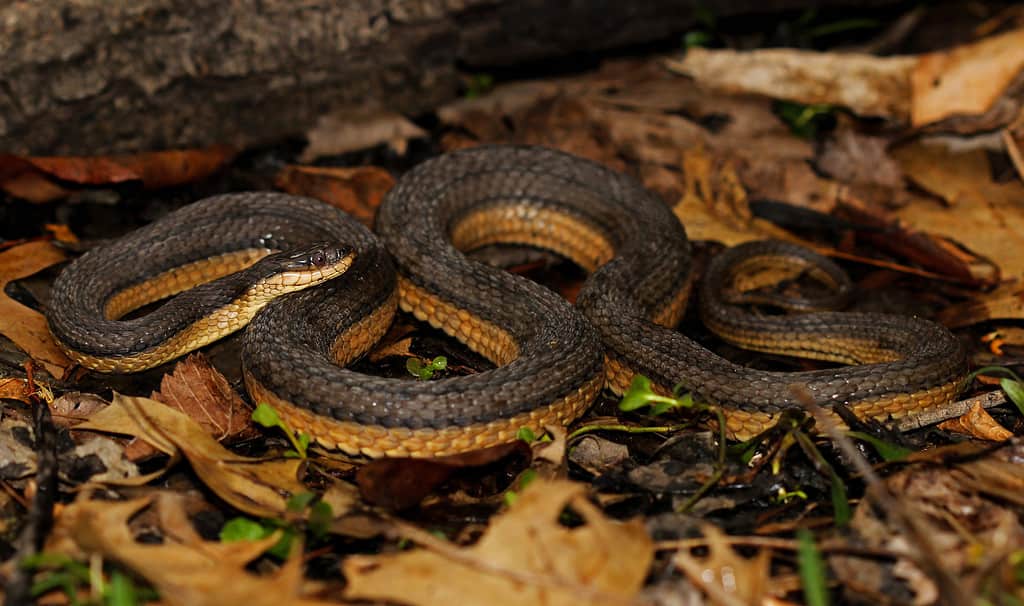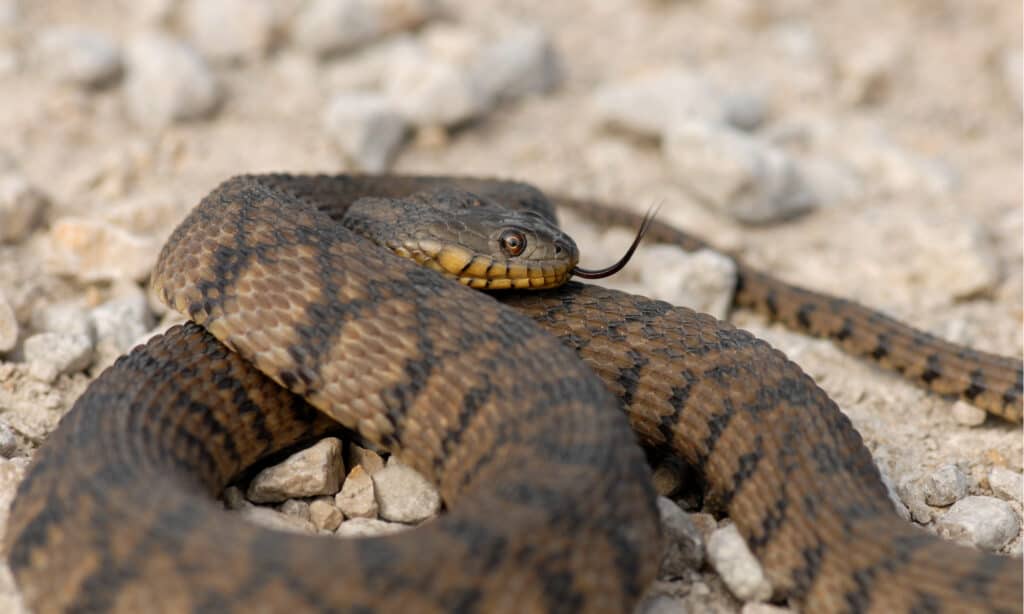Snakes are just like most other animals in the world—they seek places abundant in food, water, and shelter. It’s a common enough thing to find snakes around the Illinois River. It’s abundant in all three things animals seek. This is especially true from mid-spring to mid-fall, when snakes are at their most active, before and after hibernation.

Though Illinois has colder, longer winters than the southeast and southwest regions of the United States, that doesn’t mean they are exempt from snakes. In fact, snakes are pretty abundant in the state, with several species calling Illinois home.
Fortunately, not all of them are venomous and snakes, also like most animals, are far more petrified of humans than we are of them. For the most part, they’ll do their best to slither off somewhere and hide. However, some are indeed venomous, so it’s always a good idea to keep an eye out for snakes around the Illinois River.
1. The Northern Cottonmouth (Agkistrodon Piscivorus)

Adult northern cottonmouths can reach nearly a full yard in length.
©Ad Konings/Shutterstock.com
Down south, when a snake opens its mouth, revealing an all-white interior, it strikes fear in everyone from children to the elderly. The dreaded cottonmouth is the bane of southern rivers. However, northern rivers, like the Illinois River, aren’t exempt from the cottonmouth.
Northern cottonmouth snakes are not overly common but they are certainly abundant along the winding stretch of Illinois River. Adult northern cottonmouths can reach nearly a full yard in length and they are typically a dark, faded grey or nearly black in color.
Cottonmouths are also known as water moccasins, for a very good reason. They largely prefer the water and, while they may be rare in the state of Illinois, they frequent the middle and southern areas along the Illinois River and the most southern region of the state.
Like their southern cousins, they are instantly recognizable when they open their mouths, presenting a mouthful of what looks like pure, white cotton, hence the name. They’re very venomous, with a flesh-eating venom that can wreak havoc if left unchecked.
2. Green Water Snake (Nerodia Cyclopion)

They are non-venomous and typically frightened of
humans
.
©Jason Patrick Ross/Shutterstock.com
Green water snakes are one of the more frequent snakes found around the Illinois River. They’re also found in marshes, tributaries, and off-shoots all along the same river, as well as the entire state of Illinois. They get their name from their dark green (olive-like) scales, usually interspersed with brown blotches.
The green water snake has what are called “keeled” scales, much like other water snakes. They are non-venomous and typically frightened of humans. However, they will bite if you accidentally corner one and the bite is excruciating.
Their vertical pupils and flat head make them resemble poisonous snakes, though they are non-aggressive in nature and will typically swim away or head into the water on approach. Their primary diet is the same as most snakes along the Illinois River, including frogs, small fish, giant bugs, and small rodents, the latter of which come to the river for a drink.
They don’t just frequent the river, finding refuge all along its banks, multiple tributaries, and swamps along the way. If there is a pool of water associated with the Illinois River, there’s probably a green water snake there or one that frequents the spot.
3. Plain-Bellied Water Snake (Nerodia Erythrogaster)

Of all the snakes around the Illinois River, this is one of the most docile.
©Tyler Albertson/Shutterstock.com
These thick, well-rounded snakes are very docile looking, with solid colorations such as black, grey, green, or brown. As their name implies, they have a very innocuous-looking belly that’s either red or yellow, with no indication of lines or patterns.
They can reach up to 40″ in length, just a few inches larger than northern cottonmouths. They also go by various names—blotched belly, yellow belly, and copper belly to name a few. Ponds, lakes, marshes, tributaries, and any kind of wetlands associated with the Illinois River are likely to have plain bellies slithering around.
However, the plain-bellied water snake is more than happy to leave the water for extended periods, mostly hunting prey or hibernating for the winter. Of all the snakes around the Illinois River, this is one of the most docile.
Since they spend a lot of time away from the water, their diets are a little more varied, including crawfish, frogs, rodents, salamanders, lizards, and the occasional fish. These snakes are known for two unique features—they like to wait on their prey and set up an ambush, and occasionally, the females produce asexually.
4. Graham’s Crayfish Snake (Regina Grahamii)

This much smaller snake only grows between 18″ and 28″ in length. The adults feature a range of colors, from yellow-brown, to black and brown, to a simple dark brown. These are the most elusive of snakes around the Illinois River and are exceptionally hard to find.
It’s not a matter of rarity either. Graham’s crayfish snakes simply find another place to be whenever humans or potential predators are in the neighborhood. Since they are relatively small and quick, they can disappear fast, partially camouflaged by their natural color variations.
Though they frequent the Illinois River, they aren’t constantly in the water, preferring old rotten logs, the underside of rocks, vegetation, and any standing debris along the shorelines to hide under. As their name implies, Graham’s crayfish snakes primarily feed on crayfish, or crawfish (the latter name for those who live south of Illinois, from Kentucky on down).
Though crawfish are their primary diet source, they will also settle for smaller frogs, snails, lizards, and the tinier inhabitants of the water’s edge.
5. Diamondback Water Snake

Instead of long, poison-injecting fangs, diamondback water snakes have an entirely different defensive mechanism.
©Rusty Dodson/Shutterstock.com
Don’t confuse them with their diamondback rattlesnakes, diamondback water snakes are non-venomous and nowhere near as intimidating as their rattlesnake cousins. Instead of long, poison-injecting fangs, diamondback water snakes have an entirely different defensive mechanism. They release a powerful, foul odor from glands near their tails.
Fortunately, they will only release their musk if picked up. Otherwise, they will slither away from you in the opposite direction, as fast as they can go. Though they carry the moniker, “diamondback water snakes,” there isn’t a diamond pattern on their bodies.
Instead, they feature similar colorations to that of the diamondback rattlesnake, with a chain-like pattern of blacks and dark browns that run from head to tail. They grow to between 30″ and 50″ in length and are heavy in the middle, tapering off into a decidedly non-rattle tail.
Their primary diet is frogs, though they are known for snacking on a fish or two from time to time, so long as the timing is right and the opportunity presents itself. Frogs are just an easier, slower-moving meal that most snakes find convenient, even in the worst of times.
6. Queen Snakes (Regina Septemvittata)

The easiest way to identify a queen snake (if you’re brave enough or it’s dead), is to flip it upside down and have a look at its belly.
©Jason Patrick Ross/Shutterstock.com
Growing from 24″ to 36″ in length, queen snakes are one of the more common or standard snakes around the Illinois River. They are typically light, greyish-brown to grey—solid colors, without any variations or additional patterns.
Their underbellies are where they feature something a little more interesting. In fact, the easiest way to identify a queen snake (if you’re brave enough or it’s dead), is to flip it upside down and have a look at its belly. Queen snakes often have bright yellow or light brown undersides that feature four, distinct and inky black lines running parallel to the snake’s length.
Along the Illinois River, queen snakes are always where the current speeds up. They prefer a fast-moving current over still, stagnated water. They also like rocky riverbeds, where they spend much of their time on the hunt for frogs, fish, and other unlucky marine life.
However, their absolute favorite meal is crawfish and that’s where their true love of rocky river beds comes into play. A queen snake will make her way along the bed, essentially picking up and checking under the rocks, hoping to find a very surprised crawfish on the underside.
Final Thoughts
These are the most common snakes around the Illinois River, with the northern cottonmouth being the only venomous snake on the list. All of the other venomous snakes out there would be a rare find in the state of Illinois, or along the Illinois River.
For the most part, these snakes are fairly docile, and even the northern cottonmouth will turn tail and slither away unless you corner it on accident. All six of these snakes play a vital role in the Illinois River’s ecosystem and, if you’re lucky (depending on your level of affinity for snakes) you may spot one basking in the sun.
Summary of the 6 Snakes Slithering Around the Illinois River
| # | Snake | Danger Level |
|---|---|---|
| 1 | Northern Cottonmouth | Venomous |
| 2 | Green Water Snake | Excruciating bite |
| 3 | Plain-Bellied Water Snake | Docile |
| 4 | Graham’s Crayfish Snake | Low, avoids humans |
| 5 | Diamondback Water Snake | Release foul oder |
| 6 | Queen Snakes | Will bite if harassed |
The photo featured at the top of this post is © Laurie L. Snidow/Shutterstock.com
Discover the "Monster" Snake 5X Bigger than an Anaconda
Every day A-Z Animals sends out some of the most incredible facts in the world from our free newsletter. Want to discover the 10 most beautiful snakes in the world, a "snake island" where you're never more than 3 feet from danger, or a "monster" snake 5X larger than an anaconda? Then sign up right now and you'll start receiving our daily newsletter absolutely free.
Thank you for reading! Have some feedback for us? Contact the AZ Animals editorial team.






